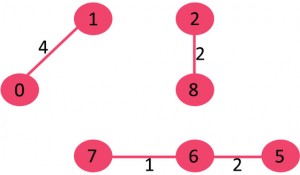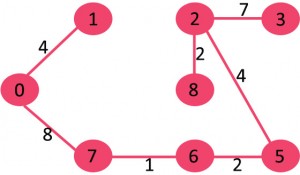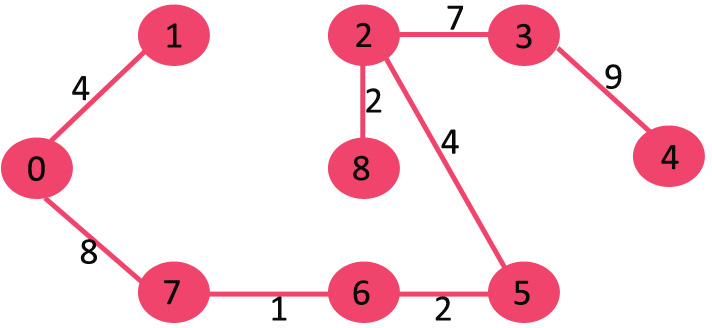Kruskal 最小生成树算法
对于一个给定的连通的无向图 G = (V, E),希望找到一个无回路的子集 T,T 是 E 的子集,它连接了所有的顶点,且其权值之和为最小。

因为 T 无回路且连接所有的顶点,所以它必然是一棵树,称为生成树(Spanning Tree),因为它生成了图 G。显然,由于树 T 连接了所有的顶点,所以树 T 有 V - 1 条边。一张图 G 可以有很多棵生成树,而把确定权值最小的树 T 的问题称为最小生成树问题(Minimum Spanning Tree)。术语 "最小生成树" 实际上是 "最小权值生成树" 的缩写。
Kruskal 算法提供一种在 O(ElogV) 运行时间确定最小生成树的方案。Kruskal 算法基于贪心算法(Greedy Algorithm)的思想进行设计,其选择的贪心策略就是,每次都选择权重最小的但未形成环路的边加入到生成树中。其算法结构如下:
- 将所有的边按照权重非递减排序;
- 选择最小权重的边,判断是否其在当前的生成树中形成了一个环路。如果环路没有形成,则将该边加入树中,否则放弃。
- 重复步骤 2,直到有 V - 1 条边在生成树中。
上述步骤 2 中使用了 Union-Find 算法来判断是否存在环路。
例如,下面是一个无向连通图 G。

图 G 中包含 9 个顶点和 14 条边,所以期待的最小生成树应包含 (9 - 1) = 8 条边。
首先对所有的边按照权重的非递减顺序排序:
Weight Src Dest 1 7 6 2 8 2 2 6 5 4 0 1 4 2 5 6 8 6 7 2 3 7 7 8 8 0 7 8 1 2 9 3 4 10 5 4 11 1 7 14 3 5
然后从排序后的列表中选择权重最小的边。
1. 选择边 {7, 6},无环路形成,包含在生成树中。
![]()
2. 选择边 {8, 2},无环路形成,包含在生成树中。

3. 选择边 {6, 5},无环路形成,包含在生成树中。

4. 选择边 {0, 1},无环路形成,包含在生成树中。

5. 选择边 {2, 5},无环路形成,包含在生成树中。

6. 选择边 {8, 6},有环路形成,放弃。
7. 选择边 {2, 3},无环路形成,包含在生成树中。

8. 选择边 {7, 8},有环路形成,放弃。
9. 选择边 {0, 7},无环路形成,包含在生成树中。

10. 选择边 {1, 2},有环路形成,放弃。
11. 选择边 {3, 4},无环路形成,包含在生成树中。

12. 由于当前生成树中已经包含 V - 1 条边,算法结束。
C# 实现的 Kruskal 算法如下。
1 using System; 2 using System.Collections.Generic; 3 using System.Linq; 4 5 namespace GraphAlgorithmTesting 6 { 7 class Program 8 { 9 static void Main(string[] args) 10 { 11 Graph g = new Graph(9); 12 g.AddEdge(0, 1, 4); 13 g.AddEdge(0, 7, 8); 14 g.AddEdge(1, 2, 8); 15 g.AddEdge(1, 7, 11); 16 g.AddEdge(2, 3, 7); 17 g.AddEdge(2, 5, 4); 18 g.AddEdge(8, 2, 2); 19 g.AddEdge(3, 4, 9); 20 g.AddEdge(3, 5, 14); 21 g.AddEdge(5, 4, 10); 22 g.AddEdge(6, 5, 2); 23 g.AddEdge(8, 6, 6); 24 g.AddEdge(7, 6, 1); 25 g.AddEdge(7, 8, 7); 26 27 Console.WriteLine(); 28 Console.WriteLine("Graph Vertex Count : {0}", g.VertexCount); 29 Console.WriteLine("Graph Edge Count : {0}", g.EdgeCount); 30 Console.WriteLine(); 31 32 Console.WriteLine("Is there cycle in graph: {0}", g.HasCycle()); 33 Console.WriteLine(); 34 35 Edge[] mst = g.Kruskal(); 36 Console.WriteLine("MST Edges:"); 37 foreach (var edge in mst) 38 { 39 Console.WriteLine("\t{0}", edge); 40 } 41 42 Console.ReadKey(); 43 } 44 45 class Edge 46 { 47 public Edge(int begin, int end, int weight) 48 { 49 this.Begin = begin; 50 this.End = end; 51 this.Weight = weight; 52 } 53 54 public int Begin { get; private set; } 55 public int End { get; private set; } 56 public int Weight { get; private set; } 57 58 public override string ToString() 59 { 60 return string.Format( 61 "Begin[{0}], End[{1}], Weight[{2}]", 62 Begin, End, Weight); 63 } 64 } 65 66 class Subset 67 { 68 public int Parent { get; set; } 69 public int Rank { get; set; } 70 } 71 72 class Graph 73 { 74 private Dictionary<int, List<Edge>> _adjacentEdges 75 = new Dictionary<int, List<Edge>>(); 76 77 public Graph(int vertexCount) 78 { 79 this.VertexCount = vertexCount; 80 } 81 82 public int VertexCount { get; private set; } 83 84 public IEnumerable<int> Vertices { get { return _adjacentEdges.Keys; } } 85 86 public IEnumerable<Edge> Edges 87 { 88 get { return _adjacentEdges.Values.SelectMany(e => e); } 89 } 90 91 public int EdgeCount { get { return this.Edges.Count(); } } 92 93 public void AddEdge(int begin, int end, int weight) 94 { 95 if (!_adjacentEdges.ContainsKey(begin)) 96 { 97 var edges = new List<Edge>(); 98 _adjacentEdges.Add(begin, edges); 99 } 100 101 _adjacentEdges[begin].Add(new Edge(begin, end, weight)); 102 } 103 104 private int Find(Subset[] subsets, int i) 105 { 106 // find root and make root as parent of i (path compression) 107 if (subsets[i].Parent != i) 108 subsets[i].Parent = Find(subsets, subsets[i].Parent); 109 110 return subsets[i].Parent; 111 } 112 113 private void Union(Subset[] subsets, int x, int y) 114 { 115 int xroot = Find(subsets, x); 116 int yroot = Find(subsets, y); 117 118 // Attach smaller rank tree under root of high rank tree 119 // (Union by Rank) 120 if (subsets[xroot].Rank < subsets[yroot].Rank) 121 subsets[xroot].Parent = yroot; 122 else if (subsets[xroot].Rank > subsets[yroot].Rank) 123 subsets[yroot].Parent = xroot; 124 125 // If ranks are same, then make one as root and increment 126 // its rank by one 127 else 128 { 129 subsets[yroot].Parent = xroot; 130 subsets[xroot].Rank++; 131 } 132 } 133 134 public bool HasCycle() 135 { 136 Subset[] subsets = new Subset[VertexCount]; 137 for (int i = 0; i < subsets.Length; i++) 138 { 139 subsets[i] = new Subset(); 140 subsets[i].Parent = i; 141 subsets[i].Rank = 0; 142 } 143 144 // Iterate through all edges of graph, find subset of both 145 // vertices of every edge, if both subsets are same, 146 // then there is cycle in graph. 147 foreach (var edge in this.Edges) 148 { 149 int x = Find(subsets, edge.Begin); 150 int y = Find(subsets, edge.End); 151 152 if (x == y) 153 { 154 return true; 155 } 156 157 Union(subsets, x, y); 158 } 159 160 return false; 161 } 162 163 public Edge[] Kruskal() 164 { 165 // This will store the resultant MST 166 Edge[] mst = new Edge[VertexCount - 1]; 167 168 // Step 1: Sort all the edges in non-decreasing order of their weight 169 // If we are not allowed to change the given graph, we can create a copy of 170 // array of edges 171 var sortedEdges = this.Edges.OrderBy(t => t.Weight); 172 var enumerator = sortedEdges.GetEnumerator(); 173 174 // Allocate memory for creating V ssubsets 175 // Create V subsets with single elements 176 Subset[] subsets = new Subset[VertexCount]; 177 for (int i = 0; i < subsets.Length; i++) 178 { 179 subsets[i] = new Subset(); 180 subsets[i].Parent = i; 181 subsets[i].Rank = 0; 182 } 183 184 // Number of edges to be taken is equal to V-1 185 int e = 0; 186 while (e < VertexCount - 1) 187 { 188 // Step 2: Pick the smallest edge. And increment the index 189 // for next iteration 190 Edge nextEdge; 191 if (enumerator.MoveNext()) 192 { 193 nextEdge = enumerator.Current; 194 195 int x = Find(subsets, nextEdge.Begin); 196 int y = Find(subsets, nextEdge.End); 197 198 // If including this edge does't cause cycle, include it 199 // in result and increment the index of result for next edge 200 if (x != y) 201 { 202 mst[e++] = nextEdge; 203 Union(subsets, x, y); 204 } 205 else 206 { 207 // Else discard the nextEdge 208 } 209 } 210 } 211 212 return mst; 213 } 214 } 215 } 216 }
输出结果如下:

参考资料
- Connectivity in a directed graph
- Strongly Connected Components
- Tarjan's Algorithm to find Strongly Connected Components
本篇文章《Kruskal 最小生成树算法》由 Dennis Gao 发表自博客园,未经作者本人同意禁止任何形式的转载,任何自动或人为的爬虫转载行为均为耍流氓。


 浙公网安备 33010602011771号
浙公网安备 33010602011771号